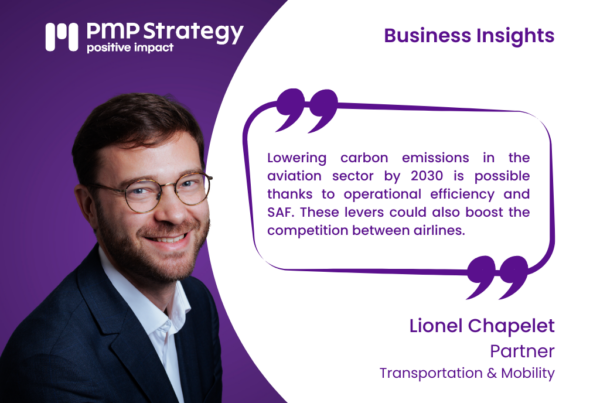The electrification of individual vehicles is a major lever for decarbonization. PMP Strategy provides a preliminary assessment of the deployment of the charging infrastructure in France and outlines their development prospects by 2035.
Electric vehicle sales on a strong growth curve
The European “Fit for 55” plan is driving European car manufacturers to accelerate the conversion of their industrial platforms to achieve 100% electric vehicle sales by 2035. Chinese manufacturers have also launched highly competitive 100% electric models in the European market. Public authorities strongly support this development through various incentives such as the conversion premium (up to €6,000) or the ecological bonus (up to €7,000) and soon, social leasing at €100/month. In the first half of the year, 100% electric vehicles accounted for 15% of sales in France, and PMP Strategy predicts that by 2035 one-third of the fleet on the road will be 100% electric.
Development of charging infrastructures keeping pace
The ability to charge at home was an important criterion when considering the purchase of first electric vehicles. Nearly 85% of active stations in 2022, which deliver 90% of the energy, are home-based. However, as electric vehicles become more popular among populations without home or workplace charging solutions, the demand for public charging (streets, open parking lots, highways) with a higher proportion of ultra-fast charging (full charge in less than 30 minutes) is increasing. PMP Strategy foresees a gradual balance between private and public charging, with the latter reaching nearly 900,000 stations by 2035, accounting for about 45% of annual charges for individual vehicles. These growth forecasts are shared by many private investors who have invested nearly €2 billion in charging station operators (Ionity, ZePlug, Electra, Bump, Powerdot, Driveco, Allego, etc.) over the past three years.
Sourcing challenges for electrical suppliers and likely increases in charging prices ahead
Manufacturers’ electrical consumptions listed in 2023 provide insights into the energy needs of electric vehicles. Still, several factors need to be considered for projections into 2030 and beyond:
- The difference between the theoretical and actual consumption for all sorts of trips, driving habits, temperature, etc.
- Increasing efficiency of batteries, electric motors, and onboard equipment, which should reduce the per-unit consumption.
- The increase in vehicle weight (due to more equipment, SUV popularity driving sales towards heavier vehicles…)
Considering these factors, our analyses estimate the energy needs for charging electric vehicles at nearly 40 TWh per year by 2035, equivalent to the annual production of six nuclear reactors. Combined with the country’s re-industrialization and the electrification needs for heating and freight transport, this trend is likely to create strong tensions in electricity markets, leading to hourly volatility and/or a rise in average charging prices, especially in public areas.
The user experience is improving, but eventually price will prevail
There is considerable room for improvement in the user experience at charging stations, especially with regard to real-time availability and payment methods. Many services are being developed to improve this (e.g., Chargemap). Interoperability is also increasing, as well as standards like Plug & Charge, which will gradually simplify the charging experience. It is likely that in the long run, as with gasoline vehicles, users will primarily seek price optimization, preferring home charging when possible. In public areas, we anticipate strong growth in destination charging (shopping centers, restaurants, etc.) with “park & charge” usage, where charging offers attract customers, as demonstrated by recent bids awarded by Carrefour to Driveco and McDonald’s to Izivia.
The “chicken or egg” debate about charging stations is slowly resolving, paving the way for a highly competitive market. We are likely to see market consolidation in the coming years to meet the growing investment needs in these new infrastructures, where entry barriers remain low and prime locations come at a high cost.
Article written by Philippe Angoustures (Partner at PMP Strategy) Hugues Marchal (Associate Partner) and Margaux de Chelle (Consultant).





